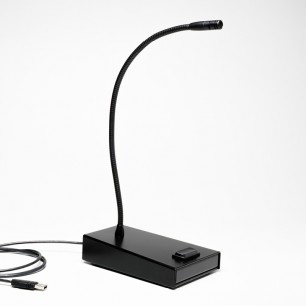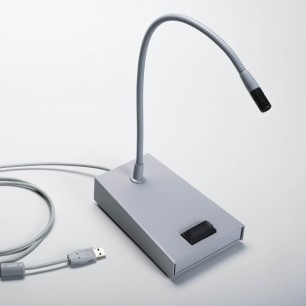There are 2 products.

What is a gooseneck microphone?
A gooseneck microphone is a type of microphone that has a flexible arm with a certain length, which is usually between 5 and 18 inches. Most of the time, they are placed on a stand or desk base instead of a cable. The base can contain various switches for push-to-talk and push-to-mute functions, or just an on/off switch. Microphones without a base can have a surface-mount preamp in order to mount flush on a specific surface.
The flexible arm, a metal tube that reminds us of a gooseneck, enables the microphone to be adjusted and positioned in the best way possible to pick up sound. Since the gooseneck can have different lengths, they typically pick up sound from the top areas and can be better adjusted to the height and position needed.
The microphone can have a windshield on the end of the gooseneck to avoid breath noise or other surrounding noise or a luminous diode to indicate if the microphone is in use, muted, or on.
Are gooseneck microphones good?
Gooseneck microphones are as good and reliable as other microphones. The choice between different types of microphones depends on the requirements of the application. There are various price ranges and functions. A good basic gooseneck microphone has a solid all-metal construction to make it durable. The flexible gooseneck offers a high degree of flexibility that other microphones don’t have. The frequency range is basically balanced and has a wide bandwidth. A good gooseneck microphone should have a clear cardioid characteristic for good sound quality.
This ensures that you pick up sounds louder from the front than from behind and in a fairly wide pattern. It is least sensitive to picking up sounds from behind. This cardioid characteristic ensures that the speaker is heard loud and clearly. Additional functions such as push-buttons or illuminations improve the overall experience.
The best gooseneck microphones
The best gooseneck microphones are lightweight, durable, and require minimal maintenance. But in order to choose the best gooseneck microphone for you, you need to know what your needs are based on how you plan to use it.
There are two types of goosenecks: dynamic and condenser. A condenser gooseneck microphone uses more expensive and delicate electronics, but it delivers clearer sound. Apart from high quality sound, which is key when using a microphone, some applications might require some more features such as a mute button, an audio filter or a very flexible and long gooseneck that is more adjustable. According to the individual requirements, it is recommended to compare different gooseneck solutions.
Some users prefer to purchase a professional gooseneck microphone because they are more expensive than consumer models but usually offer better sound quality. Another important feature of a professional gooseneck is its adjustable length, which allows you to lengthen or shorten the microphone's arm. This ensures you can capture any sound, no matter how close or far away the source is. A professional model is also better because it can handle shocks and has a longer warranty.
How Do You Use A Gooseneck Microphone?
It can be hard to make a really great sound in a room that doesn't have good acoustics. Everything becomes easier when you choose the right microphone. But if you have the right microphone equipment, you can minimize problems before they happen and make sure that customers are happy when the project is done. DPA super cardioid gooseneck microphones are the best at blocking out background noise and pointing in the right direction even in the noisiest places.
An element of the gooseneck style microphone is that long, gooseneck-style neck stand that is flexible instead of being attached to a stationary cable. Such microphones are equipped with flexible shafts that you can readjust to the right place depending on how you are using them and even direct closer to the audio sources. As a result, you get the best sound output because the microphone is closer to the location of the sound. Goosenecks can be fully adjustable, or only the top and bottom can be adjusted when regular microphones are attached to one.
How do I make it work if I want to use a gooseneck microphone wirelessly?
Many applications require wireless microphones that can easily be moved, where cable runs cannot be made or connections cannot be made. Use gooseneck microphones in wireless setups in a variety of ways; check out these options and choose the one that works best for you.
In addition to table stands, floor stands, and podiums, gooseneck mics are sometimes hung from the ceiling as well. A gooseneck can easily and quickly be adjusted by the speaker, saving recording time that way, and it comes in various lengths. Most of these mics are fixed to podiums or tables, but there are some that can be moved.
This mic is ideal because it allows you to get much closer to the sound, which is one of the main reasons why it's chosen over other microphone alternatives. You can find plenty of brands offering these gooseneck microphones for a lot of applications and styles. Because they are close to each other, you can even get a higher ratio of wanted to unwanted sounds. This gives you the following benefits that will make your recording project go much more smoothly:
-
Regardless of acoustical conditions, you gain from maximum speech intelligibility
-
Interference caused by mobile phones is rejected
-
Every microphone produces the same sound
-
The higher the gain before the feedback, the less difficult it is to place the speakers
What are gooseneck microphones used for?
It is designed for use in AV and conferencing environments, for public address paging systems, and in applications where you need to pick up spoken word but don't want to use a hand-held microphone—for example, when using a lectern. Gooseneck microphones can be used instead of boundary microphones when boundary microphones can't reach the voice source well enough.
A gooseneck microphone is perfect for you if you are looking for a hands-free microphone but still need amplification when speaking. It is easy to install and operate them. Gooseneck microphones are great for hands-free dictation, PC recording software, voice recognition, and internet chat. They can also be used for hands-free dictation, gaming, and voice recognition.
Gooseneck microphones pick up sound from the top and are usually equipped with what we call a "cardioid" microphone, which picks up sound in a relatively wide area. It would also be possible to use a super-cardioid with a more closed polar pattern, which is slightly tighter. Goosenecks that are anywhere from 5 to 18 inches long may or may not have windshields on them to block out breathing noise.
Mounting microphones can either be done using a desktop base or you can use a surface-mount preamp, which allows the microphone to be mounted flush with the surface. Most microphones have some kind of light that shows if they are on and muted or if they are not paired.
There may also be a switch that lets you turn the microphone on or off, as well as change whether it is muted or not. You can use a wired desktop base for some applications, but wireless desktop bases are more flexible for applications where you need more flexibility.
How do you connect a gooseneck microphone?
Our Plathosys gooseneck microphones have a built-in DSP (digital signal processor). Therefore, it is easy to plug in and use. The gooseneck mic will then be able to pick up voice and convert it into an electrical signal. If you're looking for a high-quality gooseneck microphone that will deliver clear sound, then you'll want to make sure you choose one with wideband audio quality and API software for the development of a customized application.
With so many options on the market, it can be tough to know which one to choose. But if you keep your eye out for a gooseneck microphone with built-in electronics, you're sure to find the perfect one for your needs. The Plathosys Gooseneck microphone is powered and connected by a 1.5-meter USB cable. It works with Microsoft Windows operating systems.
Are USB microphones as good as XLR?
It is a common misconception that USB mics are not as good as XLR mics. While it is true that XLR mics are typically better quality, there are many high-quality USB microphones available on the market. Typically, the XLR connector is more capable of containing signal disturbance.
But USB standards have been around for a long time and should be able to give good results. In fact, many professional recording studios use USB microphones for their recordings.
The reason that USB microphones are often seen as inferior is that they tend to be less expensive than XLR microphones. However, there are many high-end USB microphones that are just as good as, if not better than, XLR microphones. The main difference between the two types of microphones is the type of connector. XLR connectors are typically found on higher-end microphones, while USB connectors are found on lower-end models.
Another difference between the two types of microphones is their size. XLR microphones are typically larger than USB models. This is because XLR connectors require more space than USB connectors.


















